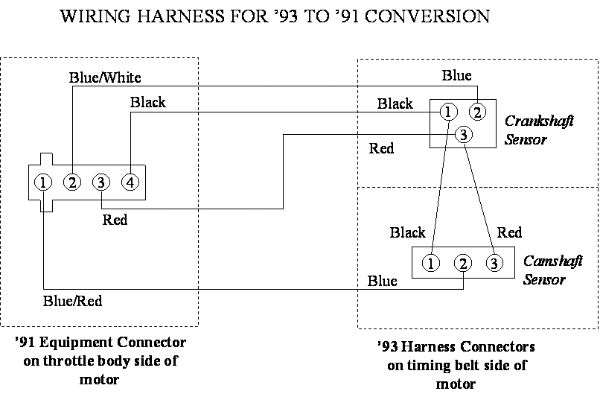6G72 DOHC CAS Conversion in the
Mitsubishi 3000 GT and Dodge Stealth
by Jeff Lucius
When owners swap a 1991-1992 6G72 DOHC engine into a 1993+ car, or a 1993+ engine into a 1992-1993 car, they are confronted with adapting the top dead center sensor (TDCS) and crankshaft angle sensor (CAS). The CAS and TDCS are both in the same housing for 1991 and 1992 DOHC models. That housing is located on the rear end of the left-bank (rear) intake camshaft, just to the front of the throttle body. I refer to both sensors and their housing collectively as the CAS. Beginning in the 1993 models (June 1, 1992 production date) and continuing till the end of production, the CAS and TDCS were separated and moved to in front of the engine. The 1991-1992 CAS can be adjusted to set basic ignition timing. The 1993+ sensors cannot be adjusted.
The 1991-1992 sensors uses a single disk with concentric rings of slots cut into it along with two LEDs and two photodiodes. As a slot passes between an LED and photodiode a small amount of current is generated by the photodidode as the LED light hits it. The outer ring has 6 slots and represents the crankshaft position sensor. The inner ring has 4 slots and represents the TDCS (also called the camshaft position sensor). The engine control unit uses both these signals to determine which cylinder is on either the compression or exhaust stroke (it makes no difference with our three coils and wasted spark ignition system). This information is used for ignition timing and fuel injection.
The CAS and TDCS on 1993 to 1999 models contain a Hall-effect switch that generates a voltage pulse from the decrease in magnetic flux as a vane on the screening plate passes by it. The 1993+ sensors put out the same number of pulses as the 1991-1992 sensors. For a detailed explanation of how the engine control unit utilizes these pulses to control ignition timing see my web page 2-ignitionsystem.htm.
There is one aspect of using 1991-1992 sensors with a 1993+ engine control unit (ECU), or 1993+ sensors with a 1991-1992 ECU that must be considered. Brian Geddes and Matt Jannusch (on the Team3S email list) pointed out that the two different types of sensor have different latency. Latency is the amount of time it takes the sensor to respond to the optical disk or vane and send a voltage change to the ECU. The ECU is programmed to accomodate the sensor latency. As determined from the AEM standalone engine management calibrations, the latency for the 1991-1992 sensors is 50 microseconds (us), or 0.050 millisecond (ms). The 1993 sensors have a 130 us latency (0.130 ms). What this means is that if you install the 1991-1992 optical pickup sensor and use a 1993+ ECU there will be more ignition timing advance than the ECU wants. If using 1993+ Hall effect sensors with a 1991-1992 ECU, there will less timing advance than what the ECU has determined is correct for the engine operating conditions. The AEM software allows a user to adjust the latency for the different types of sensor to assure the actual timing advance matches programmed advance.
This latency difference in sensor types causes a few degrees difference in timing at high rpm. For example, at 7000 rpm, a single degree of crank rotation takes place in 0.0238 ms (23.8 us); 7000 rpm = ~116.667 rps ==> ~8.57 ms/rev = 0.0238 ms/degree. There is a difference of 80 us between the two types of sensor, leading to a 3 to 4 degree difference in timing.
The drawing below was made by Greg McIntyre as part of his JDM (Japanese domestic market) engine swap (Greg's JDM engine swap). It shows how the sensors can be connected to the other style's wiring harness.
Many thanks to Greg, Brian, and Matt for their contributions to this web page.

Page last updated November 3, 2005.

